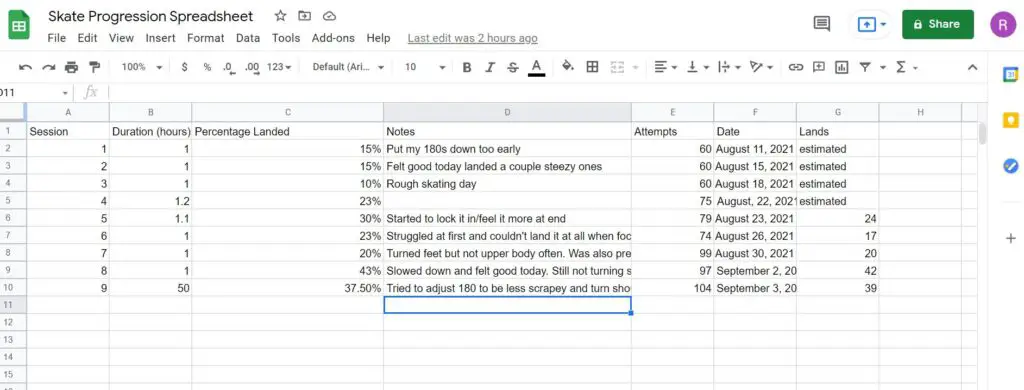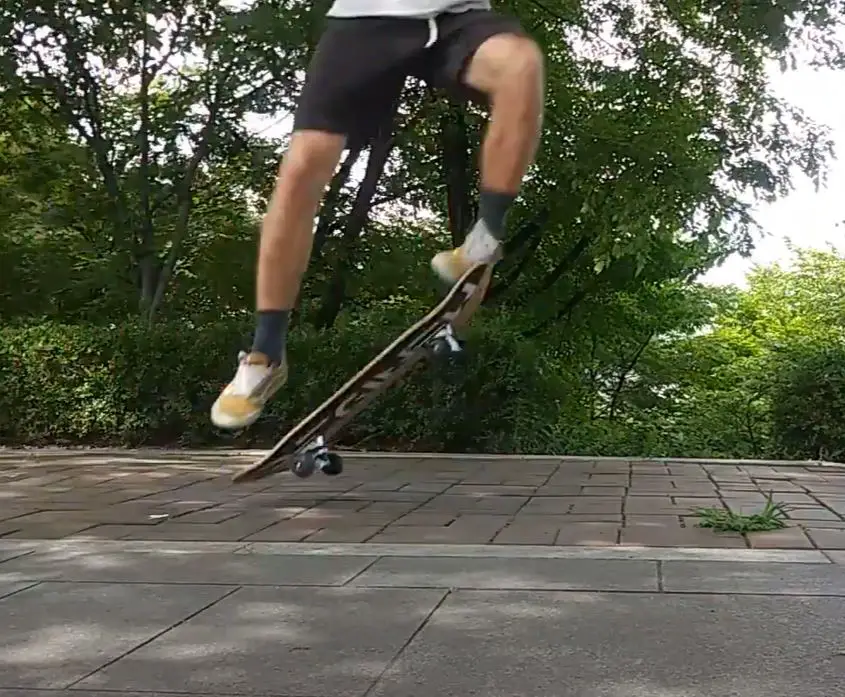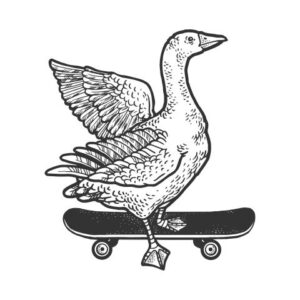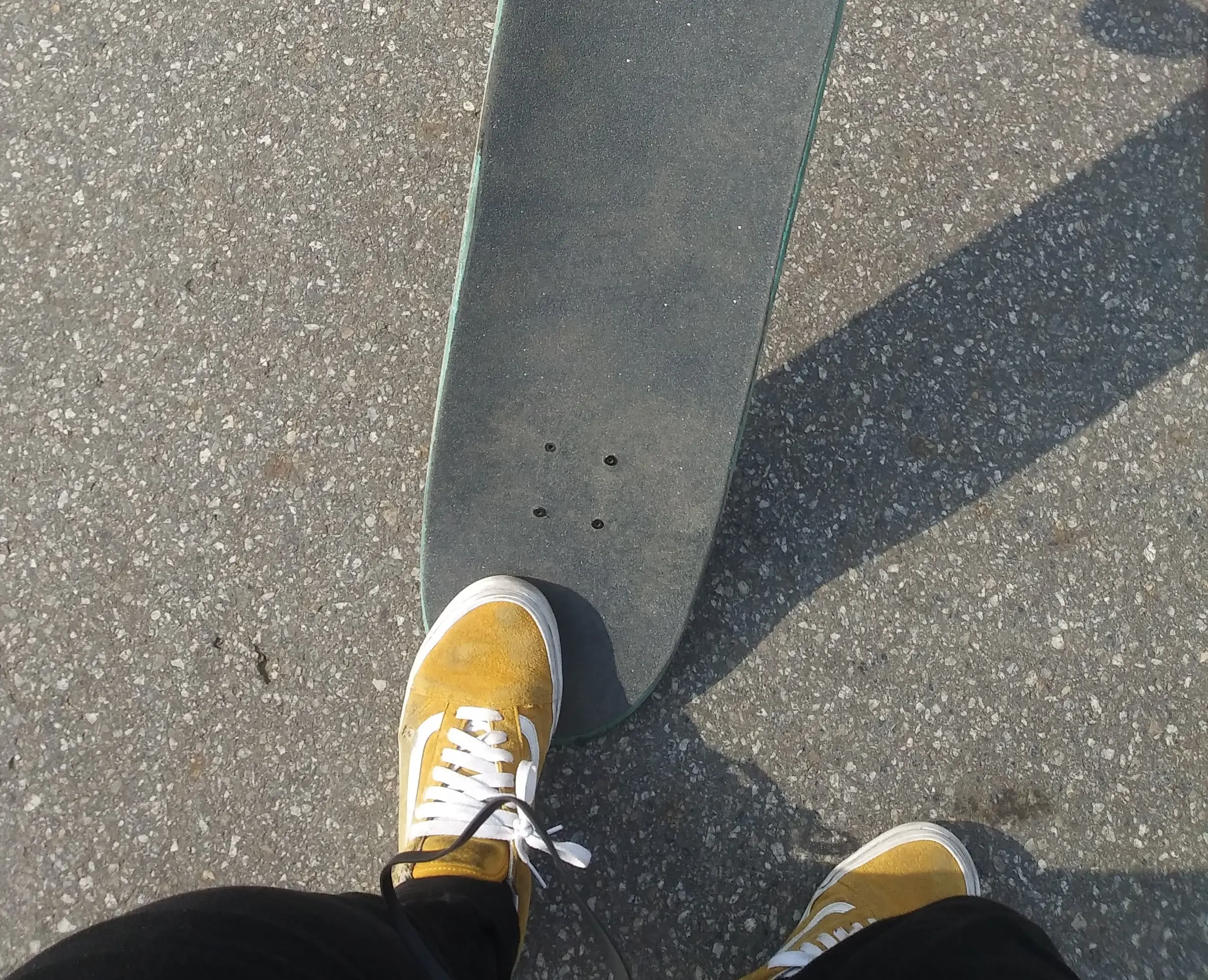Getting started skateboarding is easy with the excitement of having a new board and the novelty of a new hobby. But now that you’ve gotten started, how do you practice to improve? And where should you practice?
I’m an adult who doesn’t have so much time to skate during the week so I try to be efficient when I practice, yet also still have fun with it.
I’ll break down how I like to practice skateboarding and what helps me improve.
How to Practice Skateboarding
1. Skate Often
Skating frequently is so important to progressing in skateboarding. Your body can’t learn the motions to do a trick if you only practice it once a month.
Also skating often takes care of the most important principle behind improving; the more time you spend skating the better you will be. So if you can do anything, make sure you skate often.
But how often should you skate?
I did a Q&A on a skating forum and aggregated the results from other skaters. These were the results:
- For Fun or Exercise: 2-5 hours a week
- For Improving Your Skateboarding: 6-10 hours a week
- For Competing or Quickly Improving Your Skateboarding: 10+ hours a week
Though I should mention that I often can only skate about 4-5 hours a week and I am still able to improve. I think this is because I usually really focus on a single trick at a time and other than warming up, I mostly spend my time trying that one trick.
ACTION STEP: Go out and skate for at least three sessions this week. Try and skate for at least an hour and a half for each session.
2. Focus on One Trick at a Time
If you want to make the most of your time skating, then you should focus on one trick at a time. This can get repetitive so don’t worry if you mix it up because skating should be fun. That being said, you will improve most quickly by focusing on a single trick until it becomes natural.
The trick can be completely new or something you’ve learned but want to land it more smoothly. Just stick with a simple motion and trick until you can land it more than 60% of the time cleanly. That can take a long time for some people if you don’t skate often or are slow learners. For instance, it took me over a month to land frontside 180s consistently well.
I usually strive to land the trick over 60% of my attempts for two sessions in a row. After this, I focus less on the trick but still practice it when I warm up during sessions and while cruising.
I measure how many I land by trying the tricks in sets of 10 attempts and then writing on my phone how many I landed. So if I landed four out of ten attempts, I would write “4/10” in my phone and then go try another set of ten. I use count sketchy landings as landings but might make a note about it.
You don’t need to do this, but it is interesting and helpful for a nerd like me.

ACTION STEP: During your next skate session, focus on a single trick you want to learn or improve. Spend the majority of your session practicing this one trick.
BONUS ACTION: Record how many times you land your target trick. Try and do at least 60 attempts. Use this to gauge how well you have the trick down.
3. Video Yourself Skating
Videoing yourself skating is important because it does two things. It helps you see how much you improve and it helps you see yourself from another angle and see what you’re doing wrong.
Of course, there are other benefits like being able to show your friends and share your skating clips and memories, but seeing yourself improve helps immensely with motivation, and seeing yourself from another angle really helps fix bad habits.
If you skate alone then, you don’t have anyone watching you skate so taking video is extra important. If you still have trouble seeing what you’re doing wrong, then feel free to post the video in an online community and ask for tips.
The online community could be Reddit’s /r/NewSkaters community or a Facebook group.
ACTION STEP: Take a video of yourself attempting your target trick during your next session. It doesn’t matter if you land it or not. Just take the video then watch it or post it to see what motion you need to improve on or fix.
4. Time Spent Skating Is More Important Than Perfect Practice
This is sort of a disclaimer for everything I said. It doesn’t matter how efficiently you practice if you don’t spend a lot of time on your skateboard. Even if you’re just goofing around, time spent skating is never wasted and does help you improve.
Skateboarding is really just for fun so don’t get caught up trying to practice so you improve incredibly fast. I like to measure and focus when I practice, but really only because I enjoy doing those things. I like optimizing things and think it’s fun. I’m definitely not trying to be a professional skater and don’t want to compete with anyone.
Spending lots of time on your skateboard will help you the most. Not reading online about how to improve your practice time. (Though thanks for visiting my site 🙂 )
ACTION STEP: Go skate today if at all possible.
If you’re an absolute beginner trying to learn to skateboard, check out my guide to getting started with pushing, turning, and stopping.
Things to Practice While Skateboarding
You should practice tricks that are around your skill level, yet are still challenging. This means if you can only ollie, you should start learning backside airs, but maybe pop shuvits.
Also, you might have a trick that you can land consistently, but it looks awkward or you don’t get enough air. You can always go back and try to relearn and practice this trick in a way that looks steezier or has a better form to it.
Below is a small chart of the different groupings of skateboarding tricks by difficulty. This is by no means exhaustive but should help you get an idea of what trick to practice next.
| Group | Tricks to Learn |
| 1 | Manual, shuvit, front shuvit, kick turn, revert, ollie, caveman |
| 2 | pop-shuvit, frontside 180, kickflip, backside 180, heelflip, front pop-shuvit, boardslide |
| 3 | varial flips, tre flip, 50-50 grinds, grind variations |
| 4 | wall rides, 360 spins and variations, varial flip variations, whatever else |
Really though, as long as a trick is within your ability to learn, you should just learn what you want to. Skateboarding should be fun and if you really want to skip kickflips and learn grinds then go learn grinds. Skate how you want to skate.
Where To Practice Skateboarding
The Skatepark
The skatepark is the best place to practice skateboarding. The pavement is smooth, there are obstacles to that are designed to be skated and there are usually more experienced skaters around to meet and get help from. No street spot will beat what is available at a skatepark.
If you have a local skatepark, go skate there. There are almost always beginners at any given skatepark so don’t worry about looking new. Everyone went through that beginner stage.
Street Spots
I’m only going to mention street spots to skate and practice flat ground here. If you want to find street spots that have other obstacles like banks, handrails, and gaps then you will need to learn how to find these skate spots. That is for another guide.
Parks
Parks can be great spots to skate around and they can also be awful. There are no cars, sometimes smooth pavement, and lots of natural obstacles to learn to turn around. There can often be too many people to skate comfortably at certain times so be aware of that. Mornings are usually less crowded.
There is also a chance you’ll be asked to leave when skating in a pedestrian park. Unfortunately, this can happen.

Parking Lots
Parking lots are great for practicing flat ground and learning to skate curbs.
They usually have smoothish pavement and are often empty of witnesses so there’s no pressure to look cool as you first get started.
Parking lots are also simply everywhere. You can hop in a car and find a parking lot that you’ll be able to skate somewhere in your city or town guaranteed.
The main downside is that there aren’t any obstacles to learn to skate so you are pretty limited in what you can practice. If you want to learn to skate rails, then the parking lot is not for you.
Parking Garages
Parking garages are almost identical to parking lots, but there is cover from the rain and often you can carve down to different levels. You are also more likely to get kicked out of a parking garage.
Pop tricks can echo inside and make a lot of noise and people don’t want you skating near their cars. I’ve met some cool parking garage security guards who give me thumbs up as they drive by though.
Parking garages might be your only way out of the rain so you’ll likely go find one at some point.

Your Neighborhood Street
This is an easy place to first get rolling. It depends on how much traffic your residential street gets or not, but nothing beats the proximity and accessibility of your own street. If you’re living in the states, then there should also be room to turn and skate around. European streets tend to be more narrow.
Just be careful of parked cars as your board might shoot away from you when you fall. Also, your neighbors will likely see you skate as a total beginner. Some people will be self-conscious of this.
Your Garage
If your garage has concrete space, then you can practice skateboarding here. It isn’t ideal and practicing skating while stationary doesn’t always translate well to skating while moving.
The only benefits here are that there is cover from rain and it is accessible 24 hours a day. So maybe practicing your foot flick for kickflips in your garage is ok if you’ve already skated your local park that week.
Please, please don’t start off by only skating in your garage. You’ll never get comfortable on your board that way.
If you want to learn how to spot a good street skate spot that isn’t on this list, check out my complete guide on where to skate and how to find street spots.
Additional Questions
Can You Practice Skateboarding On Carpet?
Skateboarding inside your house is almost always a bad idea and even though skating on carpet seems harmless, you should never pop your board on the carpet.
Doing any tricks that require you to pop or spin the board can still damage the floor underneath carpet and it is generally best to avoid skateboarding on carpet. Balance tricks such as manuals won’t damage the floor underneath, but you won’t progress much as skating a carpet is not similar to skating concrete.
Really, if you don’t a concrete space to practice skateboarding, you are much better off just skating in the street in front of your home or at a local park. Damaging the floors in your home can results in thousands of dollars in repairs.
How Can You Practice Skateboarding at Home?
I wish I could get some extra skate practice at home sometimes, but I really can’t. I have a rooftop apartment and sometimes practice manuals on my roof, but that’s about all I can do.
Practicing skateboarding at home can be a challenge if you don’t have a garage, concrete space in your backyard or a quiet residential street. If you do have an open space with concrete floors, you can practice simple flat ground tricks at home. If you do not have any concrete spaces, do not practice any pop tricks indoors as this will damage your floors. Practicing your balance with manuals on a carpet is ok.
Exclusively practicing skateboarding at home is best to be avoided as it will limit your progression. However, if you already skate at the park and just want an extra hour or two of practice then it could be beneficial.
Garages are infamous home skate spots and sometimes houses will have a concrete area in the driveway or backyard to use. If you live in a large apartment complex in a city then you are likely out of luck.

How Can You Practice Skateboarding Without a Skateboard?
Practicing skateboarding without a skateboard is kind of like trying to learn to ride a bike
To truly practice and learn skateboarding, you need a skateboard. It is possible to improve your balance and get used to riding boards by practicing surfing, longboarding, and snowboarding, but this won’t directly help your skateboarding. There are people who have made DIY skateboards and began learning with those when purchasing a skateboard wasn’t possible.
A skateboard isn’t so expensive and if you are truly strapped for cash, a secondhand skateboard can be bought for as low as $30. Skate shoes and gear will raise the price as well.
If you’re traveling and just want to get some skating practice in, then search for your local private skatepark or local skate shop. Call them and ask if they have rental set-ups available. You can often rent a board for $10 a day.
If you want to know how much a complete or custom skateboard costs and where to buy one, check out my price breakdown and guide here.
Conclusion
So that’s it.
Practicing skateboarding is like learning any other new skill. It takes consistent practice time and deliberate practice. The beautiful thing about skateboarding is that you can practice anywhere there is decently smooth concrete and no one to kick you out. This opens up almost infinite street spots in big cities.
Skating at home is not ideal and skateboarding on the carpet is to be avoided. You won’t really progress much learning tricks stationary and especially on carpet anyway. That type of practice simply doesn’t translate well to skating while moving.
Anyway, thanks for reading, and look out for more content from Board and Wheels.



